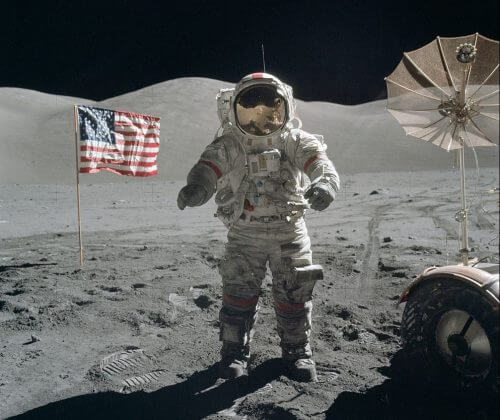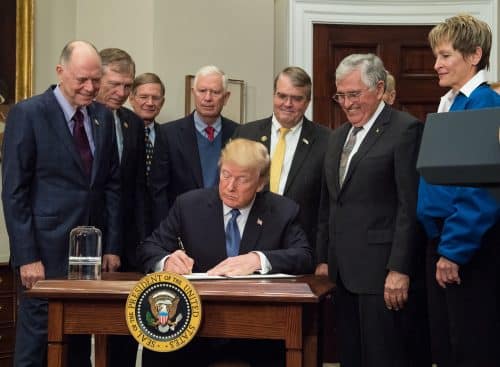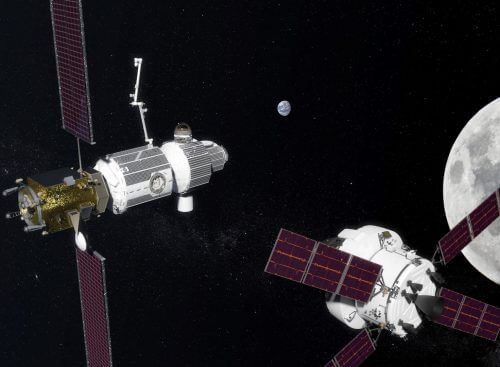The US President yesterday ordered NASA to prepare a plan to return American astronauts to the moon, and from there to lay the foundations for a future mission to Mars

US President Donald Trump yesterday signed a statement instructing NASA to act to return American astronauts to the moon and later to Mars. The ceremony of signing the declaration was held on the day that marked the 45th anniversary of the landing Apollo 17 On the lunar surface in 1972, the last time humans were sent to it.
with one of the astronauts from the same mission by his side, Jack Schmitt, And Buzz Aldrin, the second man to walk on the moon in the Apollo 11 mission, Trump said: “The order I am signing today will refocus the efforts of the US space program on manned exploration. It marks an important step in returning American astronauts to the Moon, for the first time since 1972, for long-term exploration and exploitation [of the Moon]. This time, we will not only bury our flag and leave our footprints, we will lay the foundations for a later mission to Mars, and perhaps one day to many worlds beyond."
the statement, known as Space Policy Directive-1, makes official policy the the recommendations of the National Space Council from last October, according to which NASA should "return American astronauts to the moon for its long-term research", and "strive for manned research of Mars and the rest of the solar system". In June, Trump reestablished the National Space Council after 24 years of inactivity, and placed his deputy, Mike Pence, at its head.
Vice President Pence, who led the current step, said: "Mr. President, by signing this space policy directive, you promise that America will lead in space again. To usher in this new era of American space leadership, President Trump has ordered the relaunch of the National Space Council. At the first meeting of the council in October, we unanimously decided on a recommendation to order NASA to return American astronauts to the moon, and from there lay the foundations for a mission to Mars. President Trump's action today makes this recommendation the official national policy of the United States."
Pence added in his words that an American return to the moon would ensure "that the rules and values of space exploration are written with American leadership and American values." In these words there is a reference to the concern of several American policy makers, including Trump's nominee to serve as head of NASA, member of the House of Representatives Jim Bridenstine, ambitions for the exploration and settlement of the moon of other countries, and in particular China. These believe that an American absence from the moon will allow China, which aspires to carry out advanced robotic research missions on the moon in the near future, and in the more distant future even manned missions to it, to set rules on the ground.

Trump's statement also emphasizes that setting a clear goal for returning to the moon will allow leveraging and strengthening the private space industry that began to flourish in the last decade. According to a statement published by the White House, "By refocusing our space program on achievable goals, President Trump will create incentives for the private industry that spurs the development of 21st century space capabilities."
A number of private space companies are currently offering to build landers that will allow placing cargo on the moon, andAspire to cooperate With NASA in the new plan to return to the moon. for example, Blue Origin of the founder of Amazon and the richest man in the world, Jeff Bezos, offers to build a lander that will allow placing 4.5 tons of cargo on the moon. Elon Musk's SpaceX is also considering cooperation in this area, and last September, when he revealed the The update to the private plan to establish a colony on Mars, Musk said that the giant spacecraft that the company will develop will also be able to land on the moon and allow the construction of a manned base on it. "It's 2017. I mean, we should have had a moon base by now," said So Musk.
Return to return to the moon
Yesterday's decision constitutes a significant policy change from that of the previous president, Barack Obama, who saw Mars as a direct future target of the US manned space program.
In some respects Trump's statement is reminiscent of his "vision for space exploration". He declared President George Walker Bush in 2004, under which the US intended to return to the moon and later to reach Mars. Obama Canceled In 2010, the "Constellation Program" that NASA developed based on the aforementioned vision, due to difficulties and deviations in the budget.
Instead of returning to the moon, Obama proposed that the US conduct a manned mission first to an asteroid and then to Mars. Apart from the asteroid mission, Obama's plan was very flexible and only talked about a manned mission to Mars "sometime in the 30s".
After Trump took office at the beginning of the year, and in fact from the moment he was elected in November 2016, the moon seemed to become more and more attractive than Mars. The legacy of Obama, the plan for a manned mission to an asteroid, was completely canceled last June, and now it seems that the return to the plan to return to the moon has become absolute.
How, when and how much will it cost?
Despite the understandable enthusiasm for Trump's statement, it is important to mention that this is only a statement, and not a detailed plan, which may of course come later, explaining exactly how the US will reach the moon and when; What would possible cooperation with other countries or private space companies look like; And of course, the most important detail that is missing is a budget, and a manned mission to the moon, in whatever form it takes, will not be a cheap thing.

NASA currently has no plans, at least announced, to build all the components required to land a man on the lunar surface, and return him safely to Earth. Although the agency is currently developing a new space launcher, SLS, and you Orion spacecraft, but these are not enough to realize the return to the moon in the full sense of the word - landing on the ground. The first unmanned mission of the new launcher Planned to December 2019, when NASA warned that there was a high chance that the mission would be postponed to 2020. In this mission, an unmanned Orion spacecraft will be sent into orbit around the moon. NASA's first manned mission that will launch astronauts around the moon, rather than landing on it, is currently planned to take place only around the year 2023 (in this context it is worth noting the planned mission of SpaceX, Launch two space tourists around the moon in a Dragon spacecraft, which is planned for the end of 2018. Although it is very likely that it will be postponed, but still, it is several years before the first manned mission that NASA is planning around the moon).
Another component that NASA is considering developing is a space station around the moon, the machine Deep space gateway ("Gateway to Deep Space"), but it is not yet an official NASA program. In contrast to the huge International Space Station, the proposed station will be a kind of "mini-space station", and will consist of only a few basic units that will allow for a long-term stay - a living unit, a power and propulsion unit, a logistics unit and an airlock for performing spacewalks. According to NASA, it will assist in carrying out missions to the lunar surface, will serve as a shelter for astronauts staying on the moon, as well as a transit and refueling station for space vehicles on their way to Mars.
NASA stamping Recently on a joint statement with the Russian space agency Roscosmos, which raises the possibility of cooperation between the US and Russia in the construction of the lunar space station, although the acting director of NASA, Robert Lightfoot, Bright About two months ago because "there is no commitment to resources or commitment to the program. It's all a correct concept for now." Russia is not the only country that the US aspires to assist in the construction of the space station, and other partners in the International Space Station may also participate in its construction.
For a message on the NASA website
See more on the subject on the science website:
- Who is Jim Bridenstine, Trump's nominee for the next NASA administrator?
- NASA and the Russian space agency will jointly build a space station that will attack the moon as a jumper to Mars
- Trump signed an order resurrecting the National Space Council
Watch the signing ceremony for the declaration for the return of the US to the moon:

6 תגובות
Lamotti,
It's all about money. In the 60s, because of the Cold War and the desire to prove which power had "bigger", NASA's budget It was about 4% of the total annual budget of the USA, and since then it has started to fall. In 1975 it was already 1%, and today it is about half a percent.
If there is a serious financial commitment, it will happen, but until now no government has been willing to invest the resources required for such a mission, at least not in the expensive way in which the Apollo program was done, with the absolute direction of the government and NASA.
If private companies like Elon Musk's SpaceX and Jeff Bezos' Blue Origin succeed in realizing their multi-use revolution and significantly reduce the costs of launching into space, then a mission to the moon, and also to Mars, will become much more possible, even without a financial commitment US government petition.
If I understand correctly the intention of the American government today, this is really its intention, that is to involve the private sector as much as possible. It started with Bush Jr., gained momentum with Obama, and probably continues with Trump as well. But it is unclear whether he will take this cooperation one step further, and agree to use private multipurpose launchers for deep space missions (like the powerful launcher "Heavy falcon” of Spice X). This is because NASA is developing its own Space Launcher (SLS), which will be one-off, and very expensive to develop and launch, which means it eats into NASA's already meager budget. The reason for this is mainly political - Congress obliged the Obama administration in 2011 to develop the launcher and prevent the layoffs of thousands of workers in several US states, who until then worked on the space shuttle program that ended exactly that year.
Very strange
Forty-five years ago, they managed to land astronauts on the moon again and again - and bring them back from there. nearly ten times.
And today - when it seems that technology has advanced a bit - suddenly it is so difficult and complicated...
What's going on here?
I no longer know what to say to the conspiracy enthusiasts who claim that this big break only proves that the famous landings were nothing but a false representation...
Separate words and actions
Only when it is possible to launch and land robots capable of preparing infrastructure for living will a colony be established.
For now there is nothing approaching
Every president whose maximum term is 8 years appoints countries to a program that takes much more than 8 years to execute,
Only for the next president to cancel it and choose a different policy doesn't look very promising,
The only thing that can change this is competition from China, especially the fear that they will seize economic outposts on the moon
In various asteroids that have trillions of dollars worth of minerals, as China has brutally taken over
On the entire South Sea, she will do the same in space as soon as she can, and that is what worries the USA
that the next time they want to fly to the moon they will be informed that they are entering China's outer space, and that they must leave there immediately,
You can say a lot about Trump, in the end he does things. There is nothing more important than permanent bases in space, it is difficult, it is expensive, but it is essential. In the end it will also be financial.
And for Amit, apparently if a human does not reach Mars within 30-40 years, probably no one will see a human on Mars
I am 35 years old and I hope very (very!!) that I will see a man on Mars..